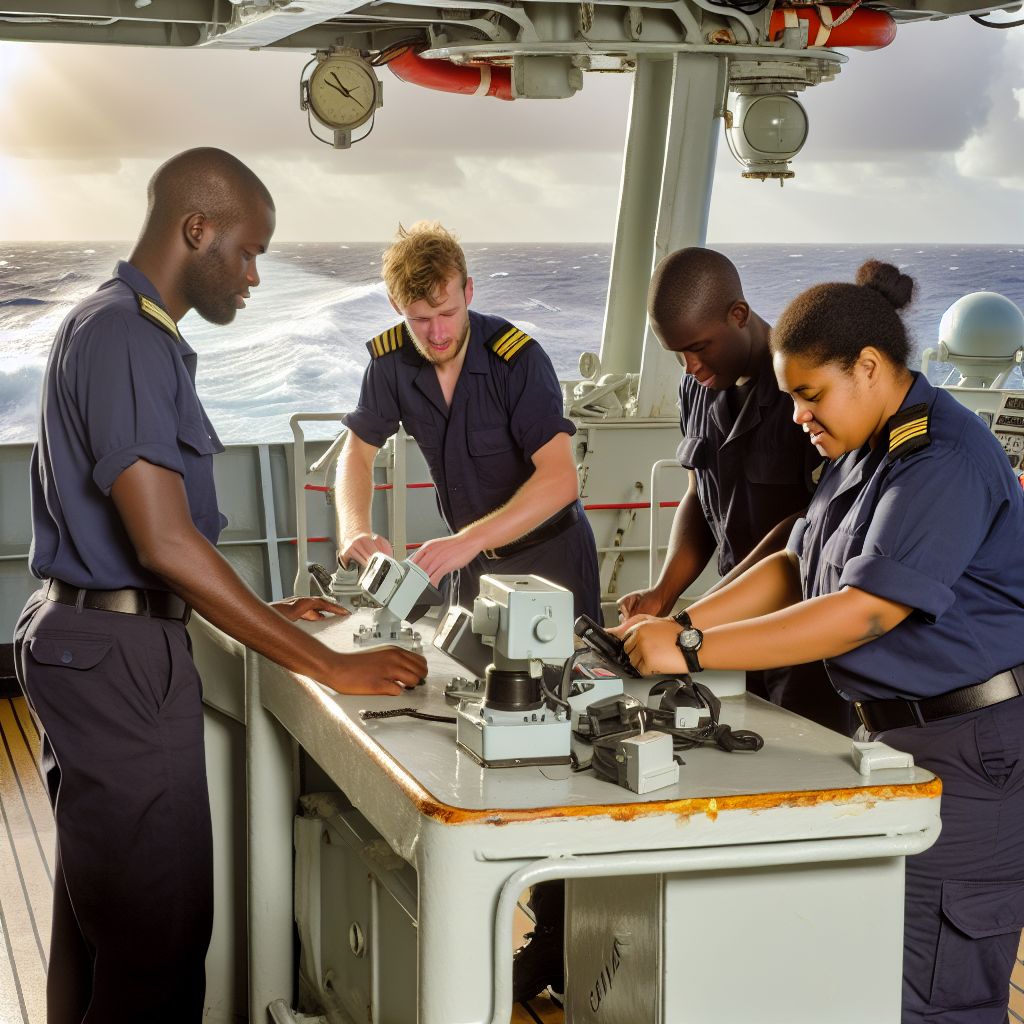Deutsch: Wachdienst / Español: Guardia de navegación / Português: Vigilância / Français: Quart de veille / Italiano: Turno di guardia
Watchkeeping in the maritime context refers to the system of organized shifts undertaken by the crew members of a ship to ensure its safe operation and navigation 24 hours a day. This continuous vigilance is critical for monitoring the ship's course, speed, navigational status, and safety, as well as for responding to any potential hazards or emergencies that may arise.
Description

Watchkeeping duties are a fundamental aspect of maritime operations, governed by strict regulations and guidelines to ensure the safety of the vessel, its crew, and cargo, as well as the protection of the marine environment. The International Convention on Standards of Training, Certification and Watchkeeping for Seafarers (STCW), administered by the International Maritime Organization (IMO), sets the international standards for watchkeeping practices aboard ships.
The responsibilities of watchkeeping officers and crew include maintaining a proper lookout by sight and hearing, operating the ship's navigation systems, recording navigational information, and ensuring that the ship is on its planned course. Watchkeeping routines are structured to ensure that at any given Time, qualified personnel are monitoring the vessel's progress and are ready to react to navigational changes, traffic situations, weather conditions, and other critical factors.
Application Areas
Watchkeeping roles and responsibilities vary depending on the type of vessel and its operation but generally include:
- Bridge Watches: Officers and crew assigned to the bridge to oversee navigation and control the ship's movement.
- Engine Room Watches: Engineers and technical crew responsible for monitoring the operation of the engine and other mechanical systems.
- Cargo Watches: On cargo ships, specific watchkeeping duties may involve oversight of the cargo, especially if it requires Special Handling or conditions.
- Safety and Security Watches: Includes monitoring security systems and conducting patrols to ensure the safety and security of the ship and its crew.
Well-Known Examples
- Officer of the Watch (OOW): The designated officer responsible for navigating and safely operating the ship during their watch period.
- Lookout: The crew member tasked with maintaining a continuous watch for obstacles, other vessels, and potential hazards at sea, primarily during night-time or in poor Visibility conditions.
Treatment and Risks
Effective watchkeeping is crucial for mitigating risks associated with maritime operations, including:
- Collision Avoidance: Proper lookout and adherence to maritime traffic regulations prevent collisions with other vessels.
- Grounding Prevention: Continuous monitoring of navigational charts and depth readings helps in avoiding grounding on underwater hazards.
- Emergency Preparedness: Ensures that the crew is ready to respond promptly to emergencies, such as fires, man-overboard situations, or equipment failures.
The challenges of watchkeeping include maintaining alertness and Decision-making capacity during long periods, especially at night or in adverse weather conditions. The STCW Convention mandates specific rest periods and work limits to combat fatigue among watchkeepers.
Similar Terms
- Duty Watch
- Navigational Watch
- Bridge Duty
Weblinks
- kriminal-lexikon.de: 'Wachdienst' in the kriminal-lexikon.de (German)
Articles with 'Watchkeeping' in the title
- Watchkeeping for Seafarers: Watchkeeping for Seafarers refers to the practice of maintaining continuous oversight and monitoring on a ship to ensure its safe navigation and operation
Summary
Watchkeeping is a critical Component of Maritime safety, ensuring that ships are navigated and operated securely around the clock. Through structured shifts and defined responsibilities, watchkeeping personnel play a vital role in preventing accidents and responding to any situations that may arise while at sea. Adherence to international standards and regulations is essential for maintaining the effectiveness and safety of watchkeeping practices.
--
Related Articles to the term 'Watchkeeping' | |
| 'Watchkeeping for Seafarers' | ■■■■■■■■■■ |
| Watchkeeping for Seafarers refers to the practice of maintaining continuous oversight and monitoring . . . Read More | |
| 'Crew Training' | ■ |
| Crew Training: Crew training in the maritime context refers to the formal education and skill development . . . Read More | |
| 'Marine Navigation' | ■ |
| Marine Navigation refers to the Process of planning, directing, and controlling the Movement of Vessels . . . Read More | |
| 'Navigator' | ■ |
| Navigator is a key role in the maritime industry, responsible for directing the course of a vessel to . . . Read More | |
| 'Skill' | ■ |
| In the maritime context, skill refers to the expertise, knowledge, and proficiency required to perform . . . Read More | |
| 'Training and Certification' | ■ |
| Training and Certification refers to the education, skill development, and official validation required . . . Read More | |
| 'Standards of Training' | ■ |
| Standards of training in the maritime context refer to the internationally recognized qualifications, . . . Read More | |
| 'Navigation and Safety' | ■ |
| Navigation and Safety: Navigation and safety in the maritime context refer to the processes, techniques, . . . Read More | |
| 'Deck Crew' | ■ |
| In the Maritime context, Deck Crew refers to the group of seafarers responsible for the Operation, Maintenance, . . . Read More | |
| 'Chief' | ■ |
| Chief in the maritime context refers to the Chief Engineer or Chief Mate, who are senior officers responsible . . . Read More | |